A New Method for Winter Wheat Mapping Based on Spectral Reconstruction Technology
Abstract
:1. Introduction
2. Study Area and Data
2.1. Study Area
2.2. Data
2.2.1. Sentinel-2 Data
2.2.2. Sample Data
2.2.3. Other Data
3. Methodology
3.1. NDVI Time Series
3.2. Reconstruction of NDVI Time Series
3.3. Similarity Calculation
3.4. Winter Wheat Identification and Accuracy Evaluation
4. Results
4.1. Evaluation of SVs and Reconstruction Results
4.2. Winter Wheat Mapping with SR-SVD
4.3. Comparison with Other Methods
5. Discussion
5.1. Selection of Training Set and Threshold
5.2. Employment of Prior Knowledge
5.3. Selection of the Number of SVs
5.4. Advantages and Limitations of the SR-SVD Method
6. Conclusions
Author Contributions
Funding
Institutional Review Board Statement
Informed Consent Statement
Data Availability Statement
Conflicts of Interest
References
- Wang, Y.; Zhang, Z.; Feng, L.; Du, Q.; Runge, T. Combining multi-source data and machine learning approaches to predict winter wheat yield in the conterminous United States. Remote Sens. 2020, 12, 1232. [Google Scholar] [CrossRef] [Green Version]
- Zhang, X.-W.; Liu, J.-F.; Qin, Z.; Qin, F. Winter wheat identification by integrating spectral and temporal information derived from multi-resolution remote sensing data. J. Integr. Agric. 2019, 18, 2628–2643. [Google Scholar] [CrossRef]
- Becker-Reshef, I.; Vermote, E.; Lindeman, M.; Justice, C. A generalized regression-based model for forecasting winter wheat yields in Kansas and Ukraine using MODIS data. Remote Sens. Environ. 2010, 114, 1312–1323. [Google Scholar] [CrossRef]
- Ortiz, R.; Sayre, K.D.; Govaerts, B.; Gupta, R.; Subbarao, G.V.; Ban, T.; Hodson, D.; Dixon, J.M.; Iván Ortiz-Monasterio, J.; Reynolds, M. Climate change: Can wheat beat the heat? Agric. Ecosyst. Environ. 2008, 126, 46–58. [Google Scholar] [CrossRef]
- Zhang, D.; Fang, S.; She, B.; Zhang, H.; Jin, N.; Xia, H.; Yang, Y.; Ding, Y. Winter wheat mapping based on Sentinel-2 data in heterogeneous planting conditions. Remote Sens. 2019, 11, 2647. [Google Scholar] [CrossRef] [Green Version]
- Dong, Q.; Chen, X.; Chen, J.; Zhang, C.; Liu, L.; Cao, X.; Zang, Y.; Zhu, X.; Cui, X. Mapping winter wheat in North China using Sentinel 2A/B data: A method based on phenology-time weighted dynamic time warping. Remote Sens. 2020, 12, 1274. [Google Scholar] [CrossRef] [Green Version]
- Xu, F.; Li, Z.; Zhang, S.; Huang, N.; Quan, Z.; Zhang, W.; Liu, X.; Jiang, X.; Pan, J.; Prishchepov, A.V. Mapping winter wheat with combinations of temporally aggregated Sentinel-2 and Landsat-8 data in Shandong Province, China. Remote Sens. 2020, 12, 2065. [Google Scholar] [CrossRef]
- Godfray, H.C.J.; Beddington, J.R.; Crute, I.R.; Haddad, L.; Lawrence, D.; Muir, J.F.; Pretty, J.; Robinson, S.; Thomas, S.M.; Toulmin, C. Food security: The challenge of feeding 9 billion people. Science 2010, 327, 812–818. [Google Scholar] [CrossRef] [Green Version]
- Tilman, D.; Balzer, C.; Hill, J.; Befort, B.L. Global food demand and the sustainable intensification of agriculture. Proc. Natl. Acad. Sci. USA 2011, 108, 20260–20264. [Google Scholar] [CrossRef] [Green Version]
- Atzberger, C. Advances in remote sensing of agriculture: Context description, existing operational monitoring systems and major information needs. Remote Sens. 2013, 5, 949–981. [Google Scholar] [CrossRef] [Green Version]
- Li, F.; Zhang, C.; Zhang, W.; Xu, Z.; Wang, S.; Sun, G.; Wang, Z. Improved winter wheat spatial distribution extraction from high-resolution remote sensing imagery using semantic features and statistical analysis. Remote Sens. 2020, 12, 538. [Google Scholar] [CrossRef] [Green Version]
- Khan, A.; Hansen, M.; Potapov, P.; Adusei, B.; Pickens, A.; Krylov, A.; Stehman, S. Evaluating Landsat and RapidEye data for winter wheat mapping and area estimation in Punjab, Pakistan. Remote Sens. 2018, 10, 489. [Google Scholar] [CrossRef] [Green Version]
- Liu, J.; Zhu, W.; Atzberger, C.; Zhao, A.; Pan, Y.; Huang, X. A phenology-based method to map cropping patterns under a wheat-maize rotation using remotely sensed time-series data. Remote Sens. 2018, 10, 1203. [Google Scholar] [CrossRef] [Green Version]
- Wang, X.; Li, X.; Tan, M.; Xin, L. Remote sensing monitoring of changes in winter wheat area in North China Plain from 2001 to 2011. Trans. Chin. Soc. Agric. Eng. 2015, 31, 190–199. (In Chinese) [Google Scholar]
- Wang, S.; Azzari, G.; Lobell, D.B. Crop type mapping without field-level labels: Random forest transfer and unsupervised clustering techniques. Remote Sens. Environ. 2019, 222, 303–317. [Google Scholar] [CrossRef]
- Zhong, L.; Hu, L.; Zhou, H.; Tao, X. Deep learning based winter wheat mapping using statistical data as ground references in Kansas and northern Texas, US. Remote Sens. Environ. 2019, 233, 111411. [Google Scholar] [CrossRef]
- Dong, J.; Liu, W.; Han, W.; Xiang, K.; Lei, T.; Yuan, W. A phenology-based method for identifying the planting fraction of winter wheat using moderate-resolution satellite data. Int. J. Remote Sens. 2020, 41, 6892–6913. [Google Scholar] [CrossRef]
- Wang, L.; Liu, J.; Yang, L.; Yang, F.; Teng, F.; Wang, X. Remote sensing monitoring winter wheat area based on weighted NDVI index. Trans. Chin. Soc. Agric. Eng. 2016, 32, 127–135. (In Chinese) [Google Scholar]
- Alcantara, C.; Kuemmerle, T.; Prishchepov, A.V.; Radeloff, V.C. Mapping abandoned agriculture with multi-temporal MODIS satellite data. Remote Sens. Environ. 2012, 124, 334–347. [Google Scholar] [CrossRef]
- Prishchepov, A.V.; Radeloff, V.C.; Dubinin, M.; Alcantara, C. The effect of Landsat ETM/ETM+ image acquisition dates on the detection of agricultural land abandonment in Eastern Europe. Remote Sens. Environ. 2012, 126, 195–209. [Google Scholar] [CrossRef]
- Da Silva, M.R.; De Carvalho, O.A.; Guimarães, R.F.; Trancoso Gomes, R.A.; Rosa Silva, C. Wheat planted area detection from the MODIS NDVI time series classification using the nearest neighbour method calculated by the Euclidean distance and cosine similarity measures. Geocarto Int. 2020, 35, 1400–1414. [Google Scholar] [CrossRef]
- Hao, P.; Wang, L.; Niu, Z. Potential of multitemporal Gaofen-1 panchromatic/multispectral images for crop classification: Case study in Xinjiang Uygur Autonomous Region, China. J. Appl. Remote Sens. 2015, 9, 096035. [Google Scholar] [CrossRef]
- Pan, Y.; Li, L.; Zhang, J.; Liang, S.; Zhu, X.; Sulla-Menashe, D. Winter wheat area estimation from MODIS-EVI time series data using the Crop Proportion Phenology Index. Remote Sens. Environ. 2012, 119, 232–242. [Google Scholar] [CrossRef]
- Yang, Y.; Tao, B.; Ren, W.; Zourarakis, D.P.; Masri, B.E.; Sun, Z.; Tian, Q. An improved approach considering intraclass variability for mapping winter wheat using multitemporal MODIS EVI images. Remote Sens. 2019, 11, 1191. [Google Scholar] [CrossRef] [Green Version]
- Murthy, C.S.; Raju, P.V.; Badrinath, K.V.S. Classification of wheat crop with multi-temporal images: Performance of maximum likelihood and artificial neural networks. Int. J. Remote Sens. 2003, 24, 4871–4890. [Google Scholar] [CrossRef]
- Wardlow, B.; Egbert, S.; Kastens, J. Analysis of time-series MODIS 250 m vegetation index data for crop classification in the U.S. Central Great Plains. Remote Sens. Environ. 2007, 108, 290–310. [Google Scholar] [CrossRef] [Green Version]
- Sun, H.; Xu, A.; Lin, H.; Zhang, L.; Mei, Y. Winter wheat mapping using temporal signatures of MODIS vegetation index data. Int. J. Remote Sens. 2012, 33, 5026–5042. [Google Scholar] [CrossRef]
- Bargiel, D. A new method for crop classification combining time series of radar images and crop phenology information. Remote Sens. Environ. 2017, 198, 369–383. [Google Scholar] [CrossRef]
- Song, Y.; Wang, J. Mapping winter wheat planting area and monitoring its phenology using Sentinel-1 backscatter time series. Remote Sens. 2019, 11, 449. [Google Scholar] [CrossRef] [Green Version]
- Zhang, X.; Qiu, F.; Qin, F. Identification and mapping of winter wheat by integrating temporal change information and Kullback–Leibler divergence. Int. J. Appl. Earth Obs. Geoinf. 2019, 76, 26–39. [Google Scholar] [CrossRef]
- Belgiu, M.; Csillik, O. Sentinel-2 cropland mapping using pixel-based and object-based time-weighted dynamic time warping analysis. Remote Sens. Environ. 2018, 204, 509–523. [Google Scholar] [CrossRef]
- Maus, V.; Camara, G.; Cartaxo, R.; Sanchez, A.; Ramos, F.M.; de Queiroz, G.R. A time-weighted dynamic time warping method for land-use and land-cover mapping. IEEE J. Sel. Top. Appl. Earth Obs. Remote Sens. 2016, 9, 3729–3739. [Google Scholar] [CrossRef]
- Kumar, P.; Gupta, D.K.; Mishra, V.N.; Prasad, R. Comparison of support vector machine, artificial neural network, and spectral angle mapper algorithms for crop classification using LISS IV data. Int. J. Remote Sens. 2015, 36, 1604–1617. [Google Scholar] [CrossRef]
- Drusch, M.; Del Bello, U.; Carlier, S.; Colin, O.; Fernandez, V.; Gascon, F.; Hoersch, B.; Isola, C.; Laberinti, P.; Martimort, P.; et al. Sentinel-2: ESA’s optical high-resolution mission for GMES operational services. Remote Sens. Environ. 2012, 120, 25–36. [Google Scholar] [CrossRef]
- Verrelst, J.; Muñoz, J.; Alonso, L.; Delegido, J.; Rivera, J.P.; Camps-Valls, G.; Moreno, J. Machine learning regression algorithms for biophysical parameter retrieval: Opportunities for Sentinel-2 and -3. Remote Sens. Environ. 2012, 118, 127–139. [Google Scholar] [CrossRef]
- Xiao, C.; Li, P.; Feng, Z.; Liu, Y.; Zhang, X. Sentinel-2 red-edge spectral indices (RESI) suitability for mapping rubber boom in Luang Namtha Province, northern Lao PDR. Int. J. Appl. Earth Obs. Geoinf. 2020, 93, 102176. [Google Scholar] [CrossRef]
- Guanter, L.; Frankenberg, C.; Dudhia, A.; Lewis, P.E.; Gómez-Dans, J.; Kuze, A.; Suto, H.; Grainger, R.G. Retrieval and global assessment of terrestrial chlorophyll fluorescence from GOSAT space measurements. Remote Sens. Environ. 2012, 121, 236–251. [Google Scholar] [CrossRef]
- Zhao, F.; Guo, Y.; Verhoef, W.; Gu, X.; Liu, L.; Yang, G. A Method to reconstruct the solar-induced canopy fluorescence spectrum from hyperspectral measurements. Remote Sens. 2014, 6, 10171–10192. [Google Scholar] [CrossRef] [Green Version]
- Yonezawa, C. Maximum likelihood classification combined with spectral angle mapper algorithm for high resolution satellite imagery. Int. J. Remote Sens. 2007, 28, 3729–3737. [Google Scholar] [CrossRef]
- Nigam, R.; Tripathy, R.; Dutta, S.; Bhagia, N.; Nagori, R.; Chandrasekar, K.; Kot, R.; Bhattacharya, B.K.; Ustin, S. Crop type discrimination and health assessment using hyperspectral imaging. Curr. Sci. 2019, 116, 1108–1123. [Google Scholar] [CrossRef]
- Löw, F.; Michel, U.; Dech, S.; Conrad, C. Impact of feature selection on the accuracy and spatial uncertainty of per-field crop classification using Support Vector Machines. ISPRS J. Photogramm. Remote Sens. 2013, 85, 102–119. [Google Scholar] [CrossRef]
- Yang, C.; Everitt, J.H.; Murden, D. Evaluating high resolution SPOT5 satellite imagery for crop identification. Comput. Electron. Agric. 2011, 75, 347–354. [Google Scholar] [CrossRef]
- Wang, X.; Qiu, P.; Li, Y.; Cha, M. Crops identification in Kaikong River Basin of Xinjiang based on time series Landsat remote sensing images. Trans. Chin. Soc. Agric. Eng. 2019, 35, 180–188. (In Chinese) [Google Scholar]
- Zhao, F.; Li, R.; Verhoef, W.; Cogliati, S.; Liu, X.; Huang, Y.; Guo, Y.; Huang, J. Reconstruction of the full spectrum of solar-induced chlorophyll fluorescence: Intercomparison study for a novel method. Remote Sens. Environ. 2018, 219, 233–246. [Google Scholar] [CrossRef]
- Hu, Q.; Wu, W.-B.; Song, Q.; Yu, Q.-Y.; Yang, P.; Tang, H.-J. Recent progresses in research of crop patterns mapping by using remote sens. Sci. Agric. Sin. 2015, 48, 1900–1914. (In Chinese) [Google Scholar]
- Li, F.; Ren, J.; Wu, S.; Zhao, H.; Zhang, N. Comparison of regional winter wheat mapping results from different similarity measurement indicators of NDVI time series and their optimized thresholds. Remote Sens. 2021, 13, 1162. [Google Scholar] [CrossRef]
- Joiner, J.; Yoshida, Y.; Guanter, L.; Middleton, E.M. New methods for the retrieval of chlorophyll red fluorescence from hyperspectral satellite instruments: Simulations and application to GOME-2 and SCIAMACHY. Atmos. Meas. Tech. 2016, 9, 3939–3967. [Google Scholar] [CrossRef] [Green Version]
- Köhler, P.; Guanter, L.; Joiner, J. A linear method for the retrieval of sun-induced chlorophyll fluorescence from GOME-2 and SCIAMACHY data. Atmos. Meas. Tech. 2015, 8, 2589–2608. [Google Scholar] [CrossRef] [Green Version]
- Whitcraft, A.K.; Vermote, E.F.; Becker-Reshef, I.; Justice, C.O. Cloud cover throughout the agricultural growing season: Impacts on passive optical earth observations. Remote Sens. Environ. 2015, 156, 438–447. [Google Scholar] [CrossRef]
- Wang, C.; Fan, Q.; Li, Q.; SooHoo, W.M.; Lu, L. Energy crop mapping with enhanced TM/MODIS time series in the BCAP agricultural lands. ISPRS J. Photogramm. Remote Sens. 2017, 124, 133–143. [Google Scholar] [CrossRef] [Green Version]
- Gao, H.; Wang, C.; Wang, G.; Li, Q.; Zhu, J. A new crop classification method based on the time-varying feature curves of time series dual-polarization Sentinel-1 data sets. IEEE Geosci. Remote Sens. Lett. 2020, 17, 1183–1187. [Google Scholar] [CrossRef]
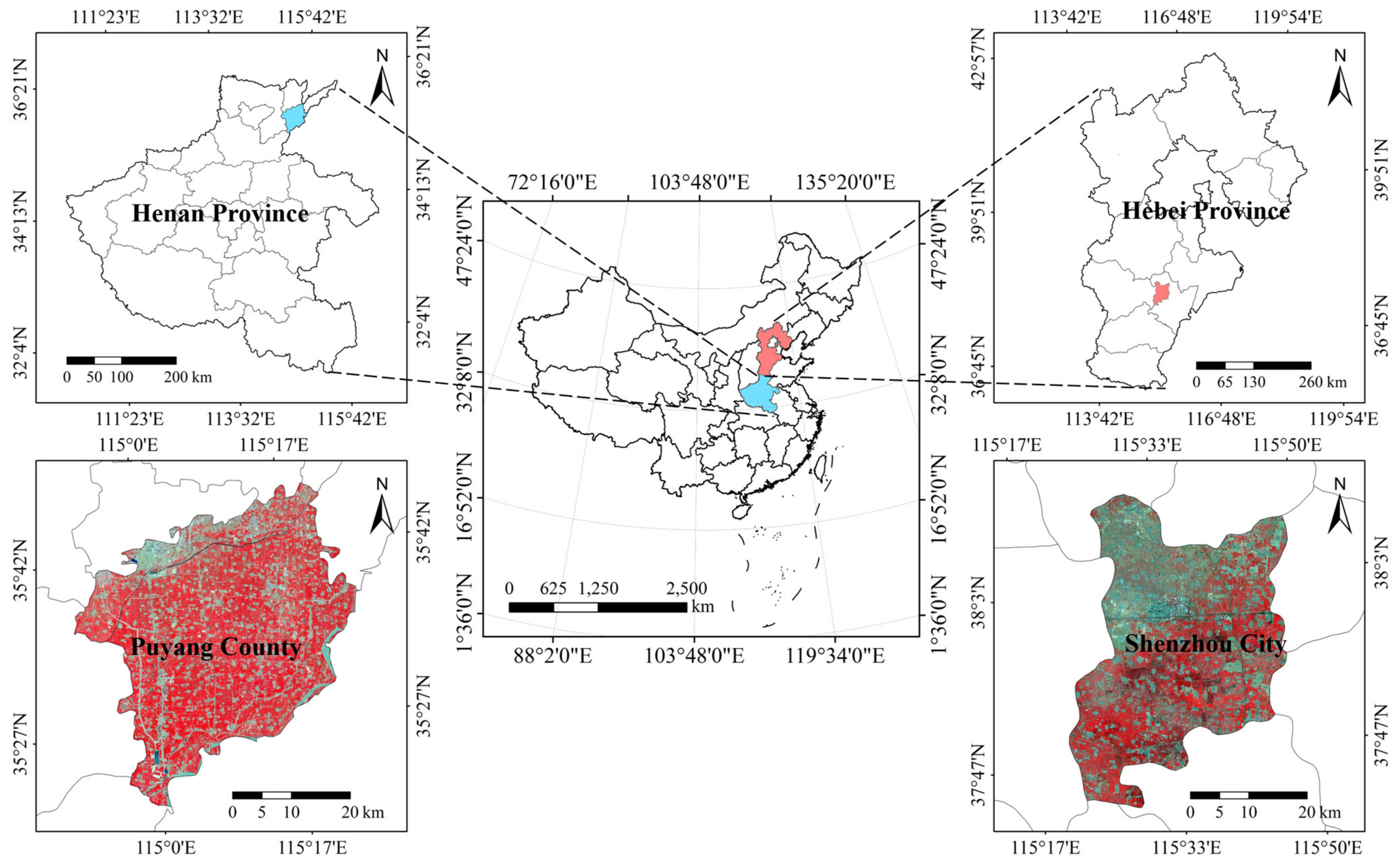
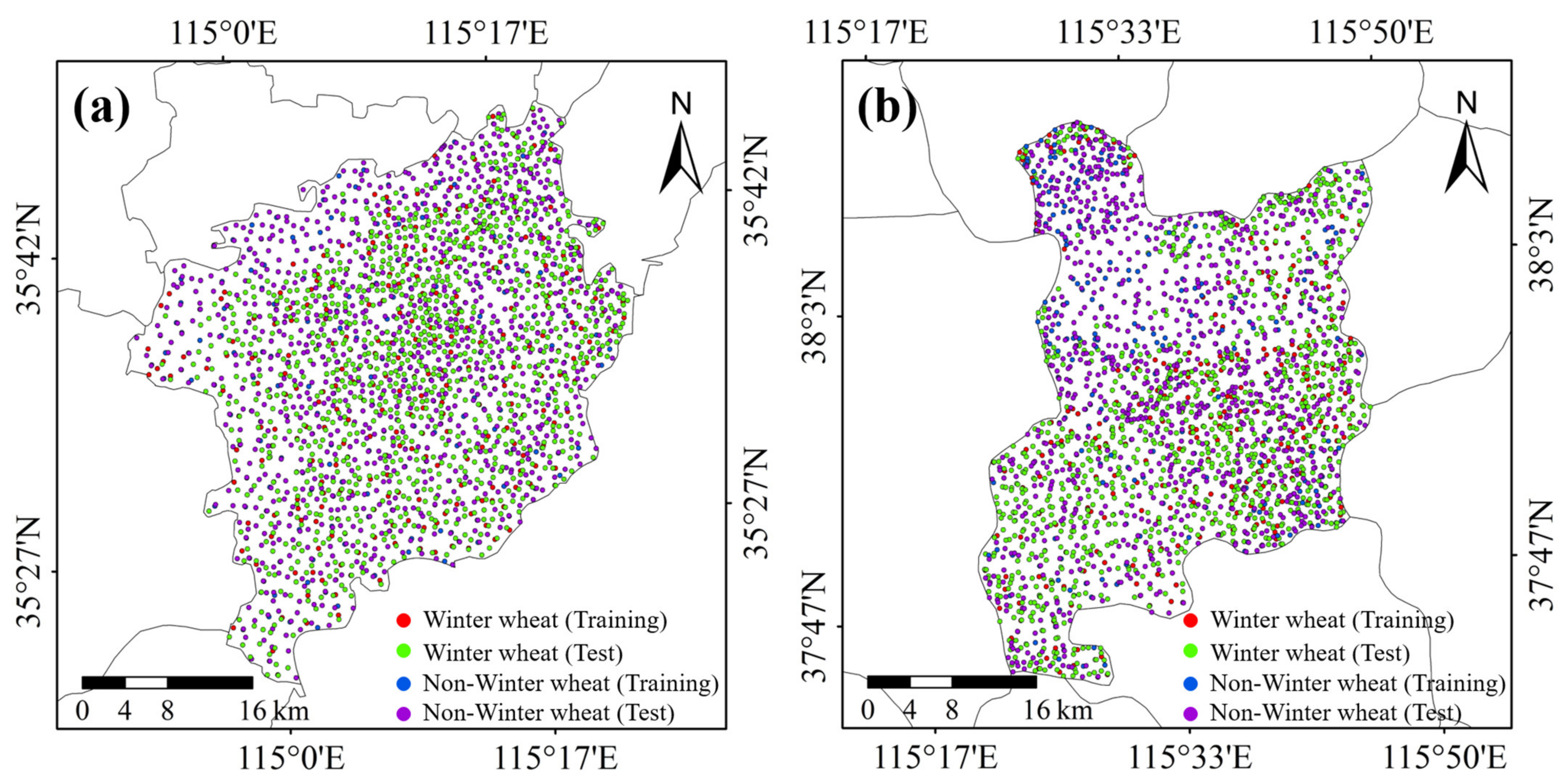


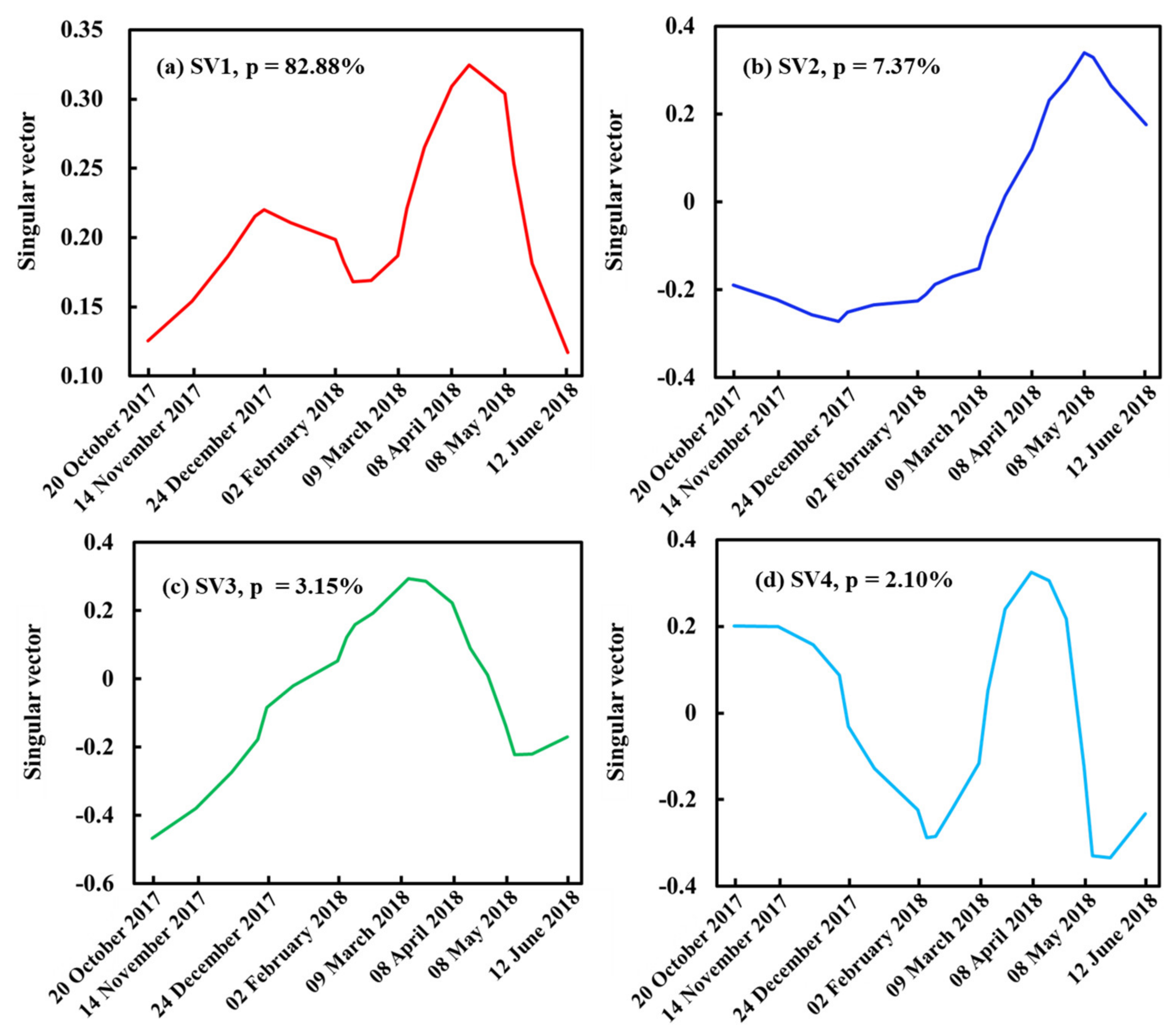
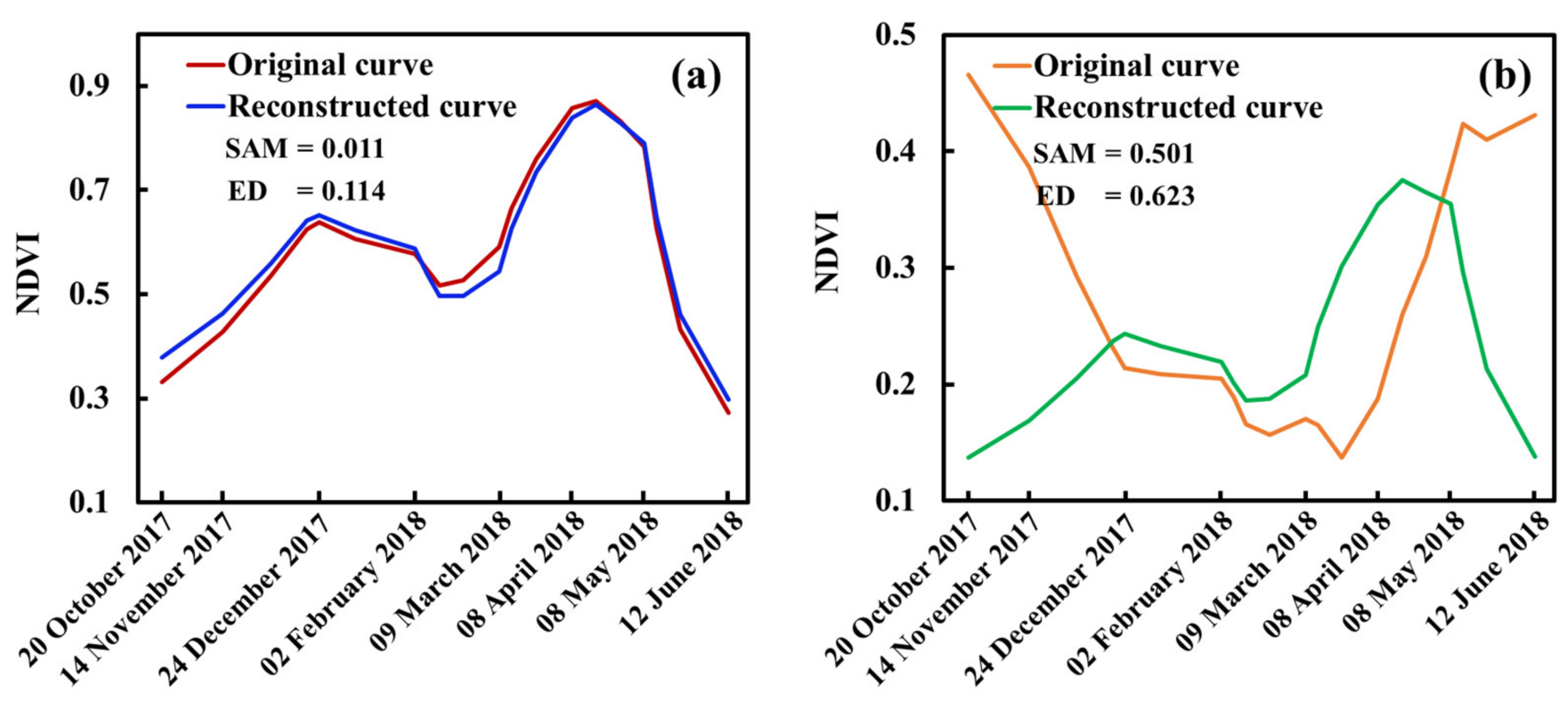
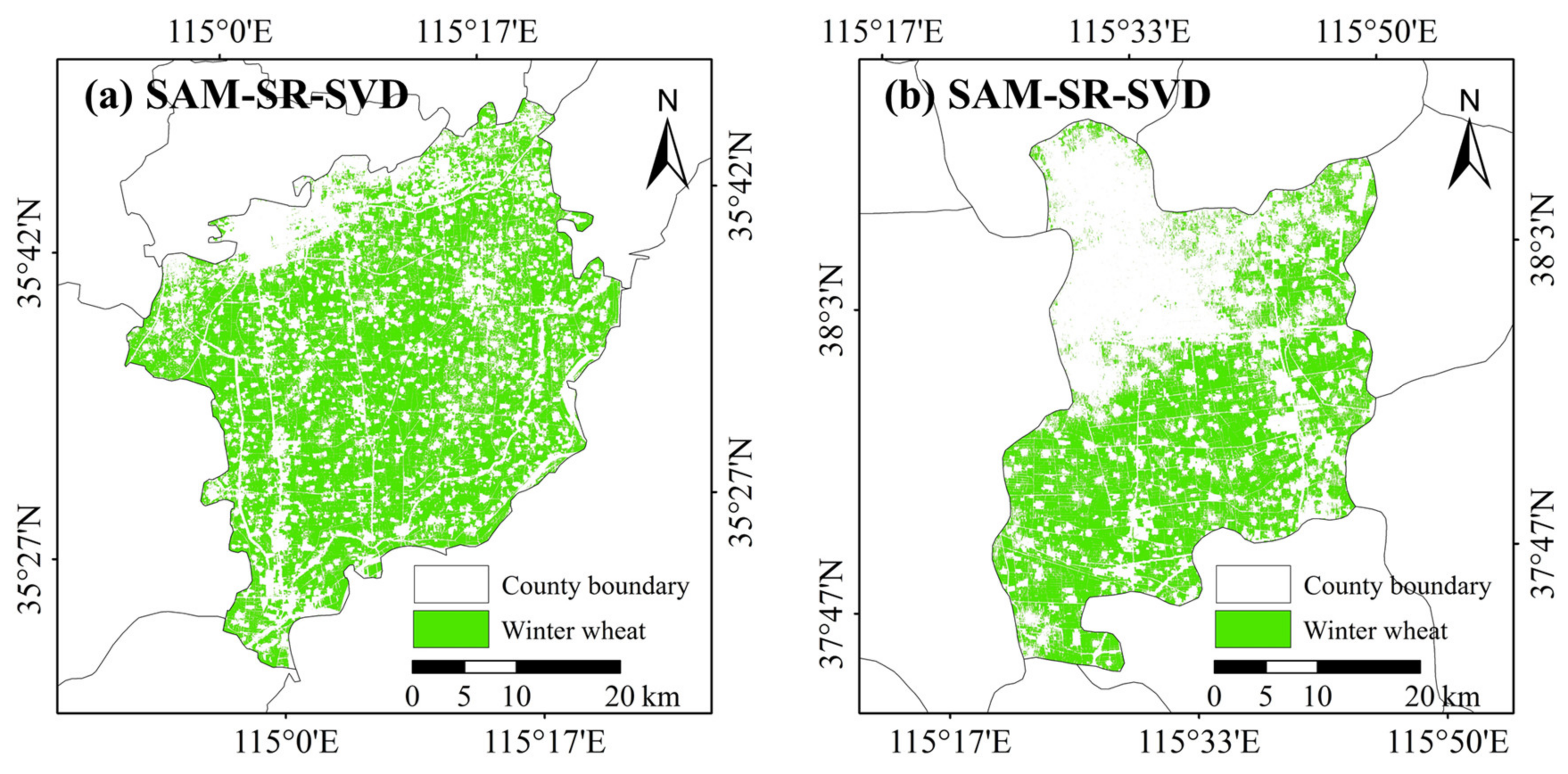
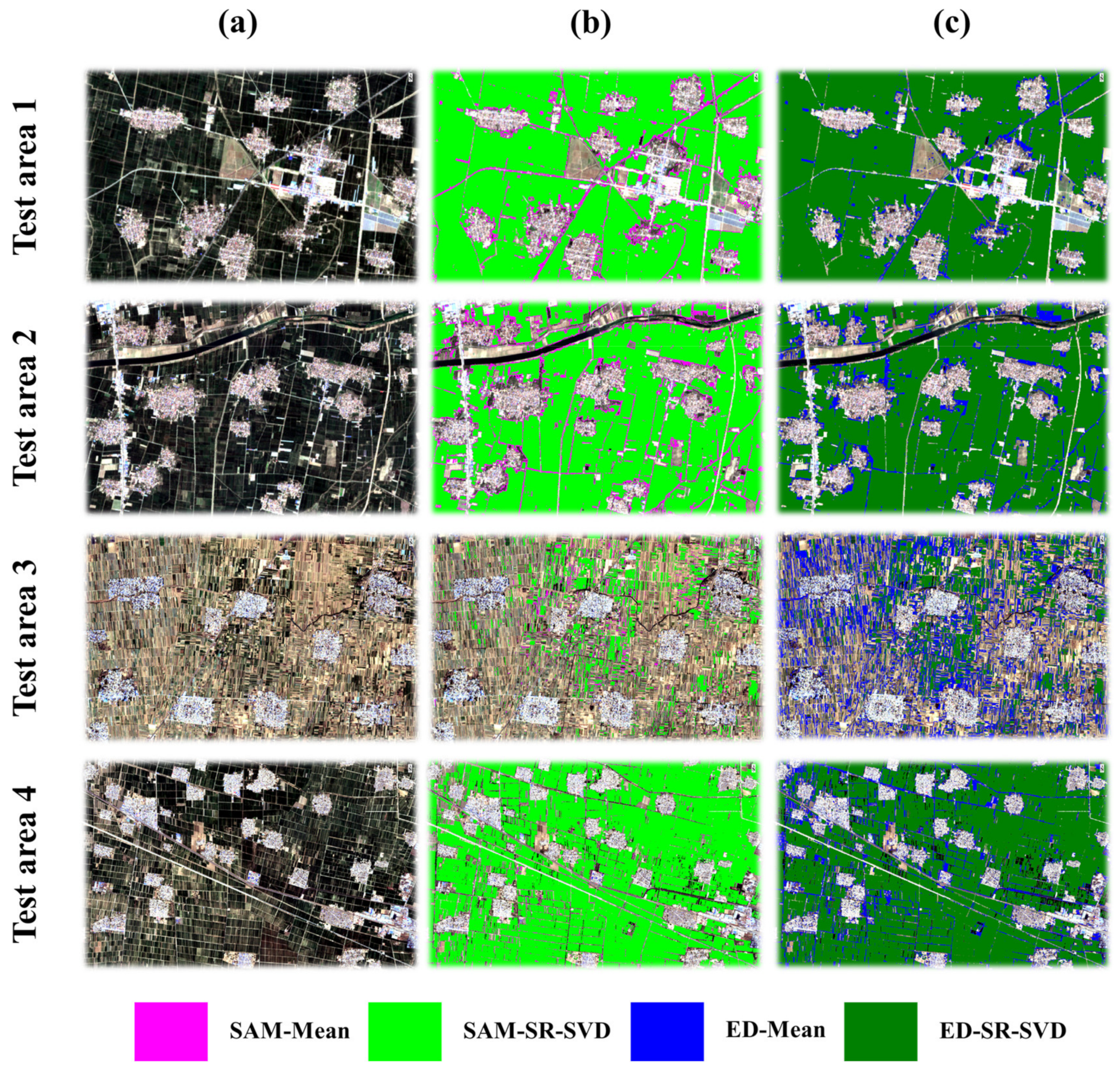

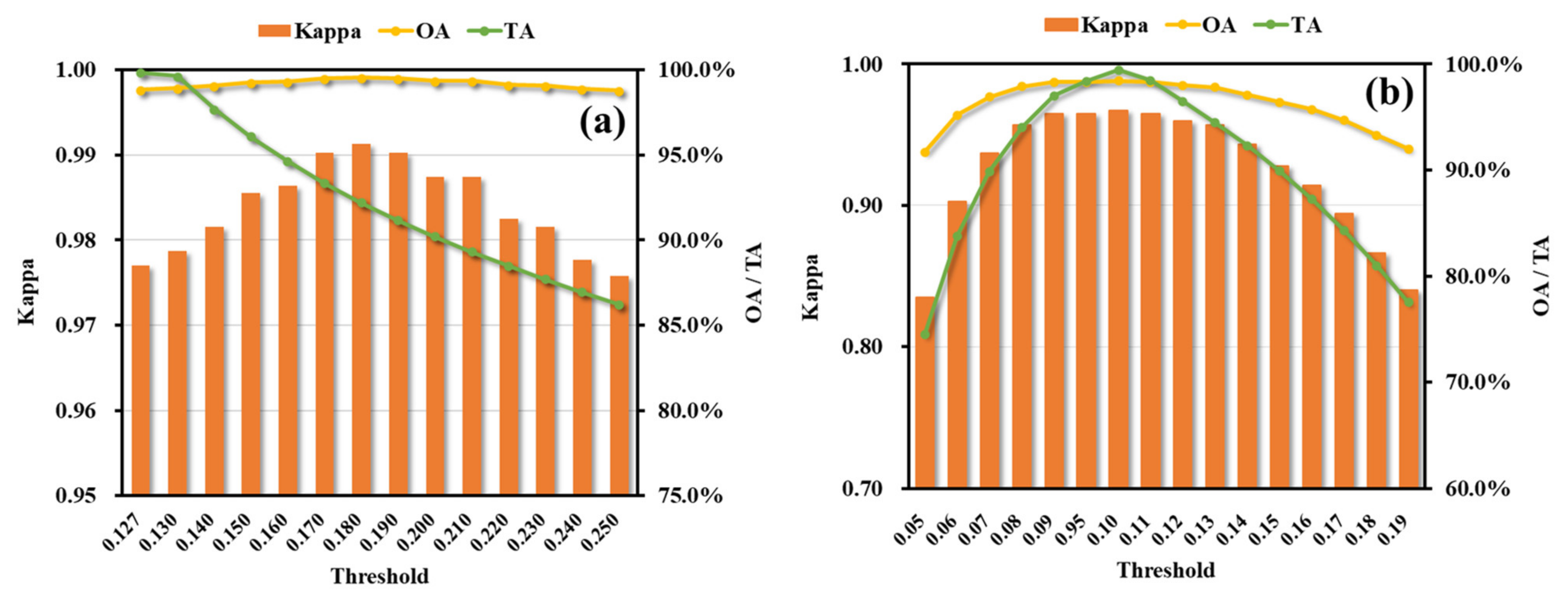
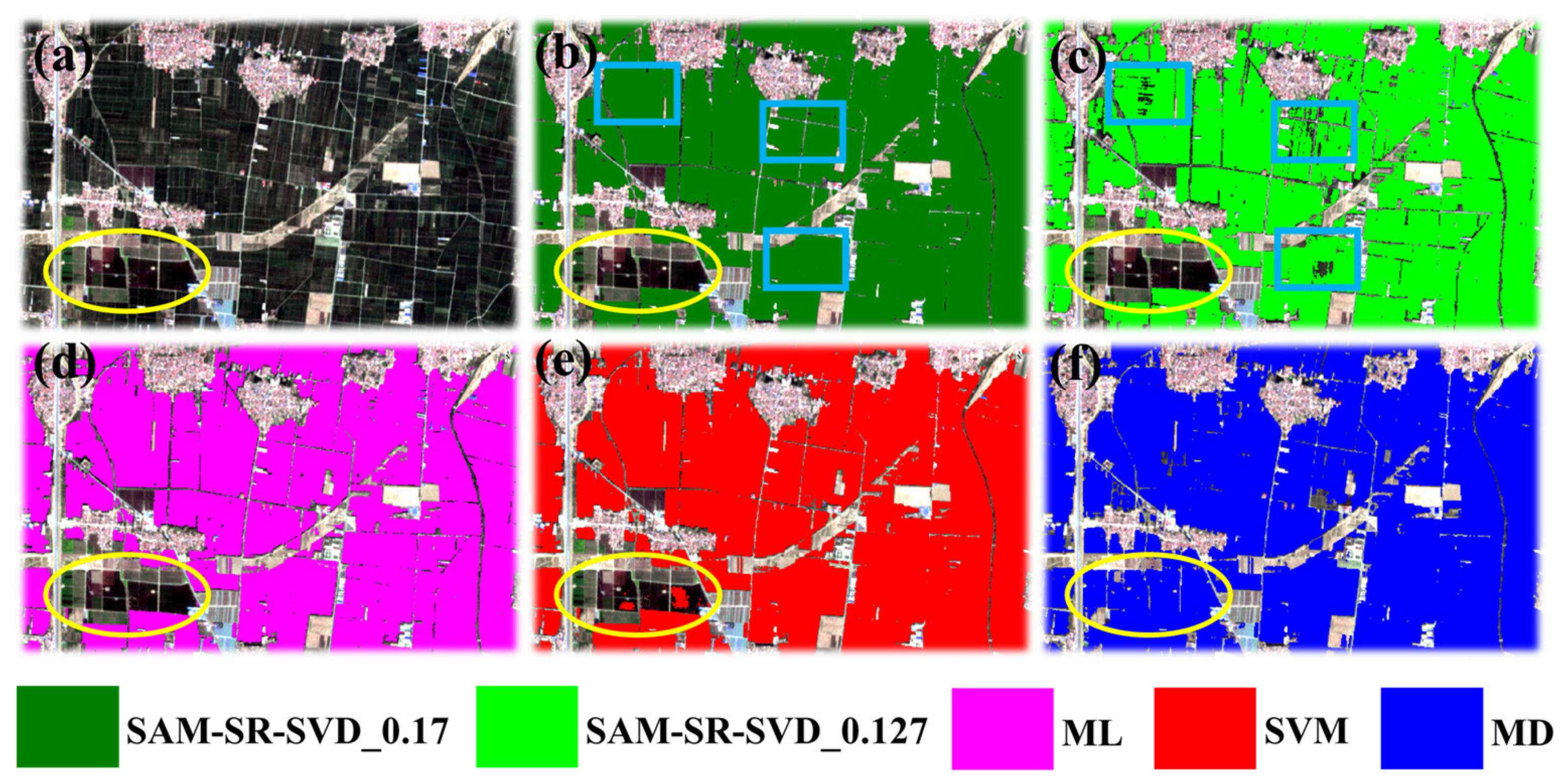


| Study Area | ID | Satellite | Scan Time (YYYY-MM-DD) | ID | Satellite | Scan Time (YYYY-MM-DD) |
|---|---|---|---|---|---|---|
| Puyang County | 1 | S2B | 2017-10-20 | 11 | S2B | 2018-03-09 |
| 2 | S2A | 2017-11-14 | 12 | S2A | 2018-03-14 | |
| 3 | S2A | 2017-12-04 | 13 | S2A | 2018-03-24 | |
| 4 | S2B | 2017-12-19 | 14 | S2B | 2018-04-08 | |
| 5 | S2A | 2017-12-24 | 15 | S2B | 2018-04-18 | |
| 6 | S2B | 2018-01-08 | 16 | S2B | 2018-04-28 | |
| 7 | S2A | 2018-02-02 | 17 | S2B | 2018-05-08 | |
| 8 | S2B | 2018-02-07 | 18 | S2A | 2018-05-13 | |
| 9 | S2A | 2018-02-12 | 29 | S2A | 2018-05-23 | |
| 10 | S2A | 2018-02-22 | 20 | S2A | 2018-06-12 | |
| Shenzhou City | 1 | S2B | 2017-10-30 | 9 | S2A | 2018-02-22 |
| 2 | S2A | 2017-11-14 | 10 | S2B | 2018-03-09 | |
| 3 | S2A | 2017-11-24 | 11 | S2A | 2018-03-24 | |
| 4 | S2A | 2017-12-04 | 12 | S2B | 2018-04-08 | |
| 5 | S2A | 2017-12-24 | 13 | S2B | 2018-04-18 | |
| 6 | S2A | 2018-01-13 | 14 | S2B | 2018-04-28 | |
| 7 | S2A | 2018-02-02 | 15 | S2B | 2018-05-08 | |
| 8 | S2A | 2018-02-12 | 16 | S2A | 2018-06-02 |
| Study Area | Land Cover Type | Training Samples | Test Samples |
|---|---|---|---|
| Puyang County | Winter wheat | 300 | 1060 |
| Non-winter wheat | 285 | 1005 | |
| Shenzhou City | Winter wheat | 295 | 1030 |
| Non-winter wheat | 305 | 1010 |
| Method | OA (%) | Kappa | TA (%) | PA (%) Winter Wheat/Non-Winter Wheat | UA (%) Winter Wheat/Non-Winter Wheat |
|---|---|---|---|---|---|
| SAM-Mean ⁂ | 97.63 | 0.953 | 83.79 * | 98.58/96.62 | 96.85/98.48 |
| SAM-SR-SVD ⁂ | 98.74 | 0.975 | 99.86 ** | 97.74/99.80 | 99.81/97.66 |
| ED-Mean ⁂ | 97.58 | 0.952 | 87.11 * | 98.68/96.42 | 96.67/98.58 |
| ED-SR-SVD ⁂ | 98.64 | 0.973 | 95.64 * | 97.74/99.60 | 99.62/97.66 |
| SAM-Mean ※ | 93.09 | 0.862 | 89.46 ** | 86.71/99.42 | 99.33/88.27 |
| SAM-SR-SVD ※ | 98.26 | 0.965 | 98.37 ** | 96.70/99.81 | 99.80/96.82 |
| ED-Mean ※ | 86.36 | 0.727 | 79.50 * | 89.72/83.03 | 84.01/89.04 |
| ED-SR-SVD ※ | 97.53 | 0.951 | 98.75 * | 96.51/98.55 | 98.51/96.60 |
| Method | OA (%) | Kappa | TA (%) | PA (%) Winter Wheat/Non-Winter Wheat | UA (%) Winter Wheat/Non-Winter Wheat |
|---|---|---|---|---|---|
| SAM- SR-SVD ⁂ | 98.74 | 0.975 | 99.86 ** | 97.74/99.80 | 99.81/97.66 |
| SVM ⁂ | 98.35 | 0.967 | 93.02 * | 99.06/97.61 | 97.77/98.99 |
| ML ⁂ | 98.21 | 0.964 | 99.58 ** | 98.58/97.81 | 97.94/98.50 |
| MD ⁂ | 95.98 | 0.919 | 87.86 * | 95.58/93.23 | 93.89/98.42 |
| SAM-SR-SVD ※ | 98.26 | 0.965 | 98.37 ** | 96.70/99.81 | 99.80/96.82 |
| SVM ※ | 96.28 | 0.884 | 94.15 * | 95.66/99.04 | 99.77/83.74 |
| ML ※ | 93.27 | 0.804 | 91.20 ** | 91.76/99.93 | 99.92/73.24 |
| MD ※ | 90.62 | 0.650 | 63.32 * | 97.40/60.58 | 91.63/84.00 |
| Method | OA (%) | Kappa | TA (%) | PA (%) Winter Wheat/Non-Winter Wheat | UA (%) Winter Wheat/Non-Winter Wheat |
|---|---|---|---|---|---|
| SAM-SR-SVD_0.17 | 99.52 | 0.990 | 93.34 * | 99.43/99.60 | 99.62/99.40 |
| SAM-SR-SVD_0.127 | 98.74 | 0.975 | 99.86 ** | 97.74/99.80 | 99.81/97.66 |
| SVM | 98.35 | 0.967 | 93.02 * | 99.06/97.61 | 97.77/98.99 |
| ML | 98.21 | 0.964 | 99.58 ** | 98.58/97.81 | 97.94/98.50 |
| MD | 95.98 | 0.919 | 87.86 * | 95.58/93.23 | 93.89/98.42 |
| Method | OA (%) | Kappa | TA (%) | PA (%) Winter Wheat/Non-Winter Wheat | Ua (%) Winter Wheat/Non-Winter Wheat |
|---|---|---|---|---|---|
| ED-SR-SVD # | 81.45 | 0.626 | 77.11 * | 97.83/64.18 | 74.23/96.56 |
| ED-SR-SVD ## | 98.64 | 0.973 | 95.64 * | 97.74/99.60 | 99.62/97.66 |
| SAM-Mean # | 86.00 | 0.718 | 69.18 * | 98.68/72.64 | 79.18/98.12 |
| SAM-Mean ## | 97.63 | 0.953 | 83.79 * | 98.58/96.62 | 96.85/98.48 |
Publisher’s Note: MDPI stays neutral with regard to jurisdictional claims in published maps and institutional affiliations. |
© 2021 by the authors. Licensee MDPI, Basel, Switzerland. This article is an open access article distributed under the terms and conditions of the Creative Commons Attribution (CC BY) license (https://creativecommons.org/licenses/by/4.0/).
Share and Cite
Li, S.; Li, F.; Gao, M.; Li, Z.; Leng, P.; Duan, S.; Ren, J. A New Method for Winter Wheat Mapping Based on Spectral Reconstruction Technology. Remote Sens. 2021, 13, 1810. https://doi.org/10.3390/rs13091810
Li S, Li F, Gao M, Li Z, Leng P, Duan S, Ren J. A New Method for Winter Wheat Mapping Based on Spectral Reconstruction Technology. Remote Sensing. 2021; 13(9):1810. https://doi.org/10.3390/rs13091810
Chicago/Turabian StyleLi, Shilei, Fangjie Li, Maofang Gao, Zhaoliang Li, Pei Leng, Sibo Duan, and Jianqiang Ren. 2021. "A New Method for Winter Wheat Mapping Based on Spectral Reconstruction Technology" Remote Sensing 13, no. 9: 1810. https://doi.org/10.3390/rs13091810







